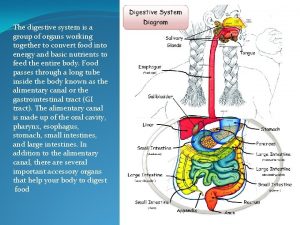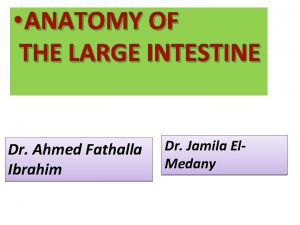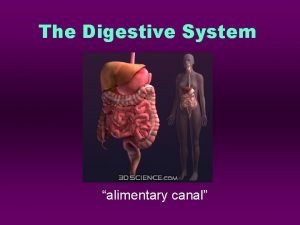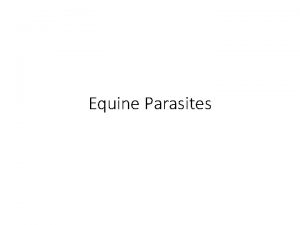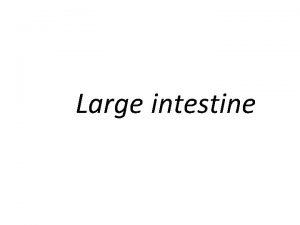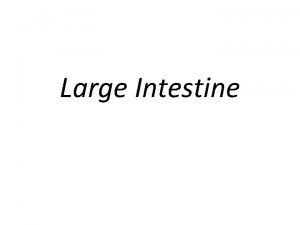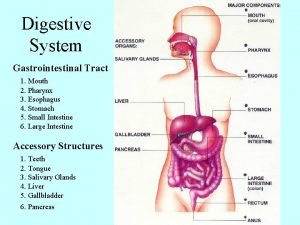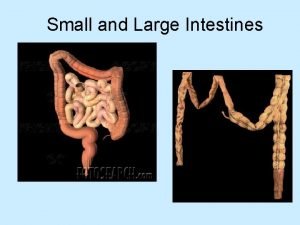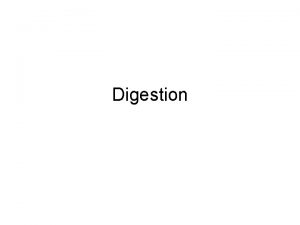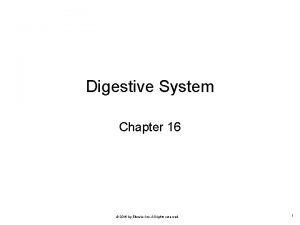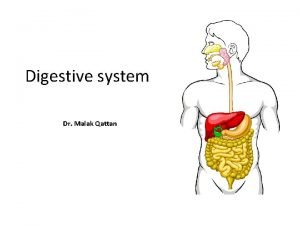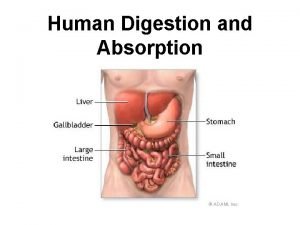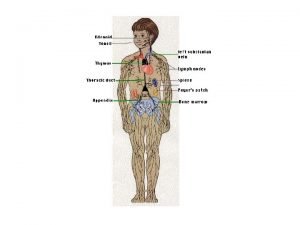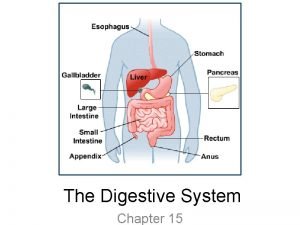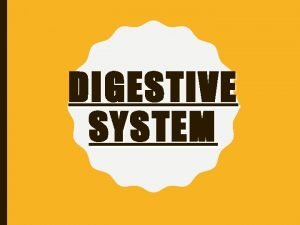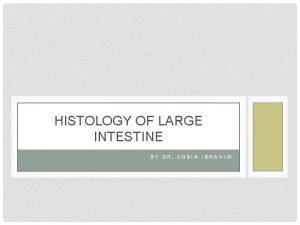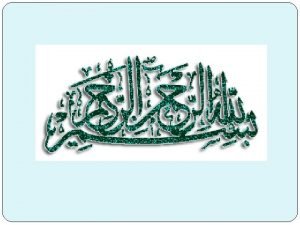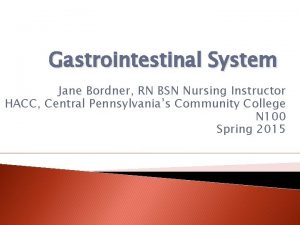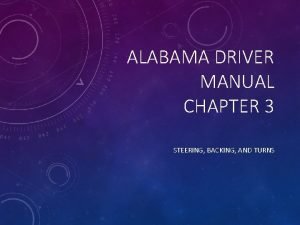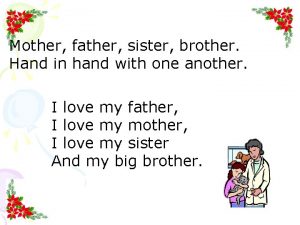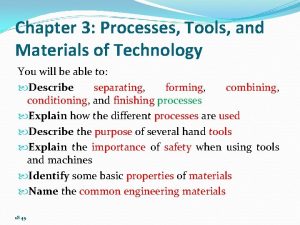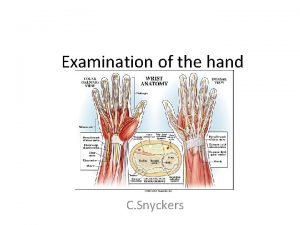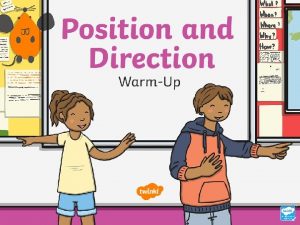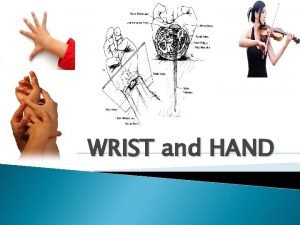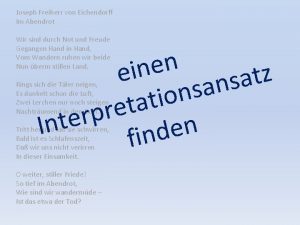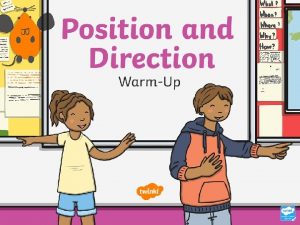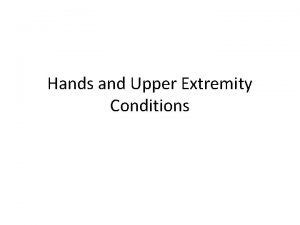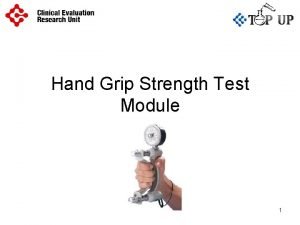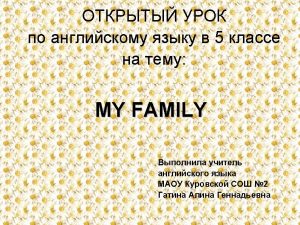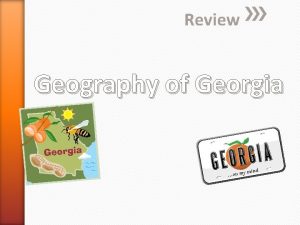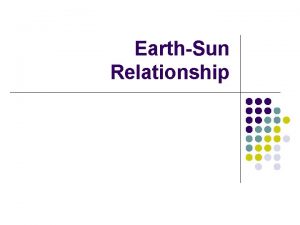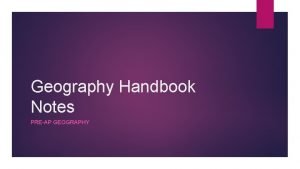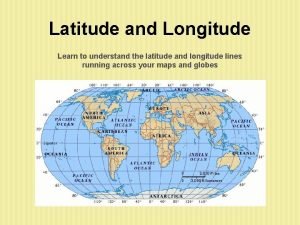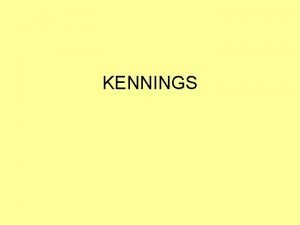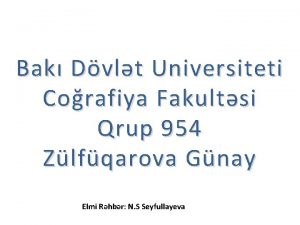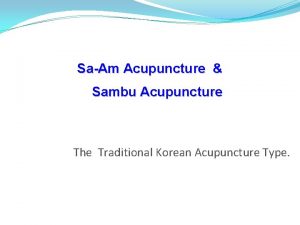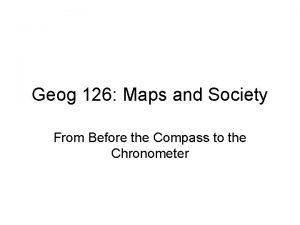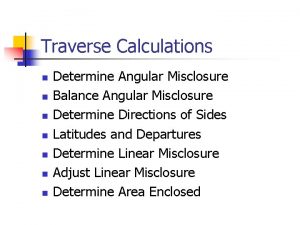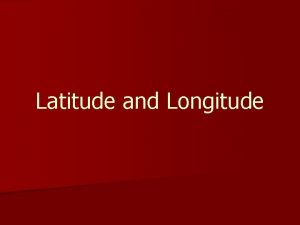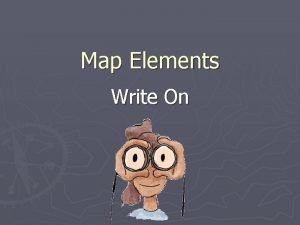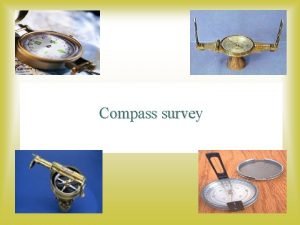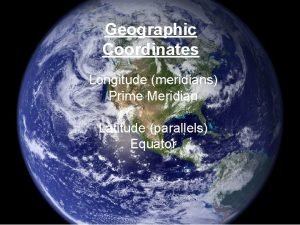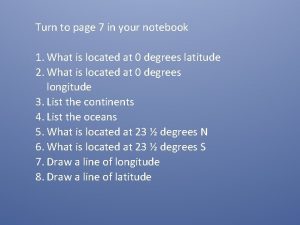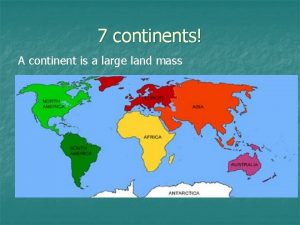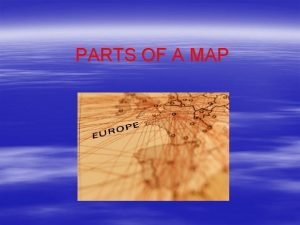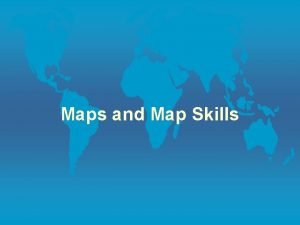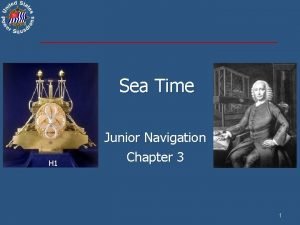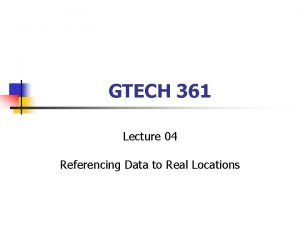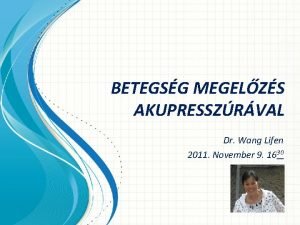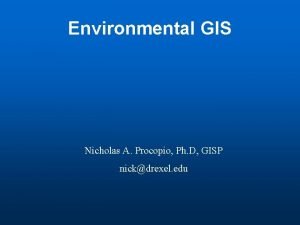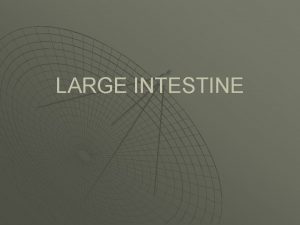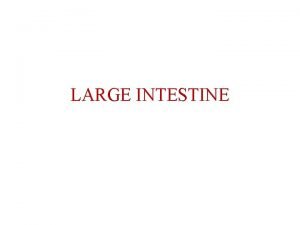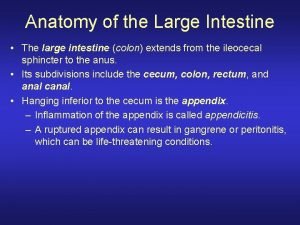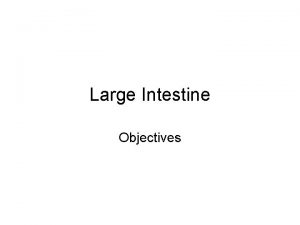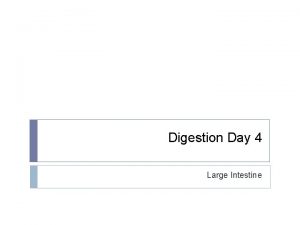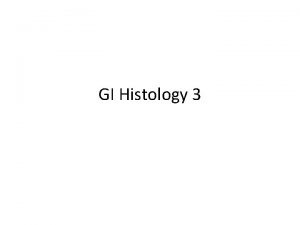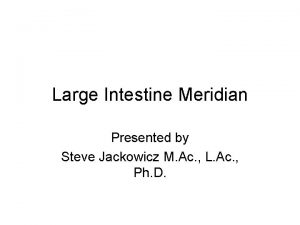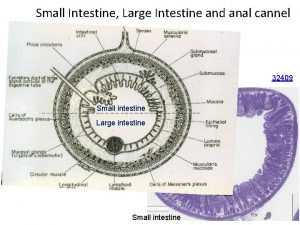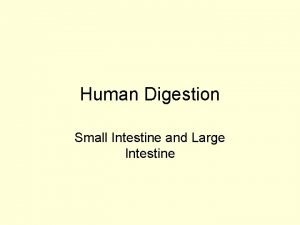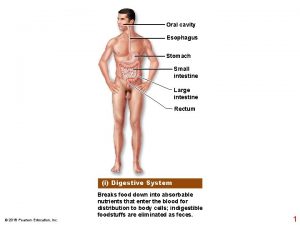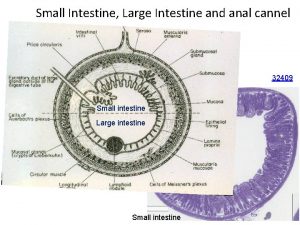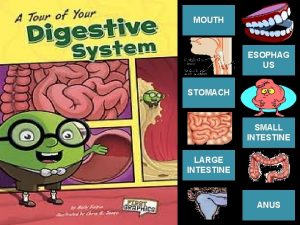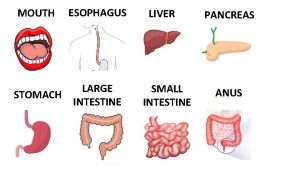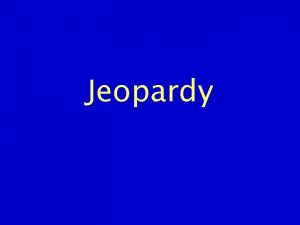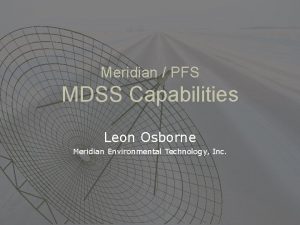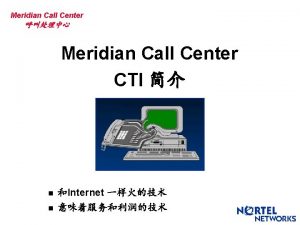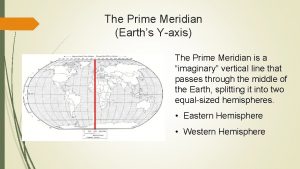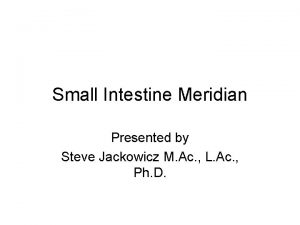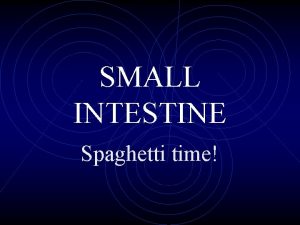Acupoints of the large intestine meridian of Hand















































































- Slides: 79

Acupoints of the large intestine meridian of Hand Yangming LU KAI-XIN lukaixincn@yahoo. com. cn kxlu@yzu. edu. cn Yangzhou University, China

Chinese Name: Shangyang (English translation: Metal Yang) ¡ Location: On the radial end of the distal phalanx of the index finger, . 1 cun (finger cun) distance from the corner of the nail.

¡ Classification: Jing-Well point of the Large Intestine Meridian ¡ Indications: ¡ Sore throat, toothache ¡ Coma caused by febrile disease ¡ Numbness at tip of index finger ¡ Deafness

¡ Functions: Clears Heat, revives consciousness, benefits the throat. ¡ Notes: Jing-Well points are where the qi bubbles up. Jing-Well points are indicated to revive consciousness. Jing-Well points are known to treat fullness below the Heart and clear Heat. ¡ Needling: Shallow insertion. 1 cun, or prick the point to bleed.

¡ Regional anatomy Vasculature: The arterial and venous network formed by the dorsal digital arteries and veins. Innervation: The palmar digital proprial nerve derived from the median nerve.

Chinese Name: Erjian (English translation: Second Space) ¡ Location: When a loose fist is made, this point is on the radial side of the index finger, in the depression distal to the metacarpophalangeal joint.

¡ Classification: Ying-Spring point of the Large Intestine Meridian ¡ Indications: ¡ Toothache, sore throat ¡ Redness and pain of the eye ¡ Pain and swelling of the joints in the index finger ¡ Functions: Clears Heat, reduces swelling, relieves pain.

¡ Method: Puncture perpendicularly 0. 2 -0. 3 inch. Moxibustion is applicable. Regional anatomy Vasculature: The dorsal digital and plamar digital proprial arteries and veins derived from the radial artery and vein. Innervation: The dorsal digital nerve of the radial nerve, and the palmar digital proprial nerve of the median nerve.

¡ Notes: Ying-Spring points are where the qi dribbles down the meridian. Ying-Spring points are indicated for heat in the body and changes in the complexion. Ying-Spring points are known to clear heat from the meridian

Chinese Name: Sanjian (English translation: Third Space) ¡ Location: When a loose fist is made, this point is on the radial side of the index finger, in the depression proximal to the metacarpo-

¡ Classification: Shu-Stream point of the Large Intestine Meridian ¡ Indications: ¡ Ophthalmalgia, toothache, sore throat ¡ Fever, redness and swelling of fingers and dorsum of the hand ¡ Functions: Clears Heat and wind, benefits the eyes and throat. ¡ Notes: Shu-Stream points are where the qi starts to pour down the meridian. They are known to alleviate heaviness and pain in the joints

¡ Method: Puncture perpendicularly 0. 5 -0. 8 inch. Moxibustion is applicable. Regional anatomy Vasculature: The dorsal venous network of the hand the branch of the first dorsal metacarpal artery. Innervation: The superficial ramus of the radial nerve.

Chinese Name: Hegu (English translation: Joining Valley) ¡ Location: On the dorsum of the hand, between the 1 st and 2 nd metacarpal bones, in the middle of the 2 nd metacarpal bone on the radial side.

¡ Classification: Yuan-Source point of the Large Intestine Meridian Command Point of the head and face

¡ Indications: ¡ Diseases of the head and face: i. e. external pathogenic headache and ¡ ¡ ¡ ¡ bodyache, dizziness, congestion, swelling and pain of the eye, nasosinusitis, epistaxis (nosebleed), toothache in the lower jaw, trismus (lockjaw), deafness, mumps, swelling of the face, facial paralysis, facial tic, swelling of the pharnyx and aphonia (inability to speak). Aversion to cold, fever, febrile disease, anhidrosis (no sweating), hidrosis. Dysmenorrhea, amenorrhea, dystocia (difficult or abnormal labor/childbirth). Gastric pain, abdominal pain, constipation, diarrhea, dysentery. Hemiplegia, finger spasm, pain in the arm, infantile convulsion, manic psychosis and irritability. Malignant sore, urticaria, scabies. Every type pf pain and psychogenic tense. Use in conjunction with LIV 3 (the Four Gates) to strongly move the qi and blood in the body in order to remove stagnation and alleviate pain.

¡ Functions: Expels Wind and releases the exterior, tonifies qi and strengthens immunity, stops pain, regulates the face and head area, induces labor.

¡ Method: Puncture perpendicularly 0. 5 -1 inch. Moxibustion is applicable. Acupuncture and moxibustion are contraindicated in pregnant women. Regional anatomy Vasculature: The venous network of the dorsum of the hand. Innervation: The superficial ramus of the radial nerve.

¡ Notes: LI 4 is a very common and useful point. It is useful for any condition related to the face and head. It's also particularly useful for Wind-Heat conditions (flu). Finally, LI 4 is known as the pain point in the body. Anywhere there is pain, use LI 4.

¡ Clinically, Yuan-Source points are of great significance in treating diseases of the internal organs. Yuan-Source points are the sites where the Yuan (Primary) qi of the Zang-Fu organs passes and stays. Puncturing the Yuan-Source points stimulates the vital energy of the regular meridians, regulates the functional activities of the internal organs, reinforces antipathogenic factors and eliminates pathogenic factors. This method of treating diseases deals principally with the root causes. The Yuan (source) point from the affected meridian is often combined with the Luo (Connecting) point of the internally-externally related meridians in use.

Anatomy picture of Hegu(LI 4) Acupoint

Chinese Name: Yangxi (English translation: Yang Stream) Location: On the radial side of the dorsal crease of the wrist, when the thumb is pointed upwards, it is in the depression between the tendons m. extensor pollicis longus and brevis.

¡ Classification: Jing-River point of the Large Intestine Meridian ¡ Indications: ¡ Frontal headache, congestion, swelling and pain of the eye. ¡ Toothache ¡ Weakness of the wrist. ¡ Functions: Expels Wind, clears Yangming Fire, benefits the throat


¡ Method: Puncture perpendicularly 0. 3 -0. 5 inch. Moxibustion is applicable. Regional anatomy Vasculature: The cephalic vein, the radial artery and its dorsal carpal branch. Innervation: The superficial ramus of the radial nerve.

Anatomy picture of Yangxi(LI 5) Acupoint

¡ Notes: Jing-River points are where the qi of the meridian begins to flow more heavily. They are known to treat cough and asthma due to pathogenic cold or heat.

Chinese Name: Pianli (English translation: Veering Passageway) ¡ Location: With the elbow flexed, the point is on the dorsal radial side of the forearm, on the line connecting LI 5 and LI 11, 3 cun above the wrist crease

¡ Classification: Luo-Connecting point of the Large Intestine Meridian ¡ Indications: ¡ Dental cavities ¡ Deafness ¡ Facial paralysis ¡ Edema, aching in the dorsum of the hand ¡ Functions: Expels Wind, clears Heat, opens the water passages.

¡ Method: Puncture perpendicularly or obliquely 0. 5 - 0. 8 inch. Moxibustion is applicable. Regional anatomy Vasculature: The cephalic vein. Innervation: On the radial side, the lateral antebrachial cutaneous nerve and the superficial ramus of the radial nerve; on the ulnar side, the posterior antebrachial cutaneous nerve and the posterior antebrachial interosseous nerve.

¡ Notes: Luo-Connecting points of one meridian communicate with two meridians. They treat diseases of the collaterals and can be used to treat chronic diseases, especially chronic diseases of the Zang-Fu organs. Clinically, Luo-Connecting points are often combined with Yuan-Source points in the treatment of diseases.

Chinese Name: Wenliu (English translation: Warm Flow) ¡ Location: With the elbow flexed, the point is on the dorsal radial side of the forearm, on the line connecting LI 5 and LI 11, 5 cun above the wrist crease

¡ Classification: Xi-Cleft point of the Large Intestine Meridian ¡ Indications: ¡ Acute abdominal pain, borborygmus ¡ Aching shoulders and back ¡ Facial paralysis, swelling of face ¡ Functions: Clears Heat and detoxifies, expels Wind, benefits the throat

¡ Method: Puncture perpendicularly 0. 5 -1. 0 inch. Moxibustion is applicable. Regional anatomy Vasculature: The muscular branch of the radial artery, the cephalic vein. Innervation: The posterior antebrachial cutaneous nerve and the deep ramus of the radial nerve.

¡ Notes: A Xi-Cleft point is the site where the Qi of the meridian is deeply converged. Qi and blood are stored deeply at these particular points. If there appear abnormal reactions at X-Cleft points, it shows that the pathogens have entered the deeper parts of Zang-Fu organs. Thus, they are used for acute, painful symptoms, inflammation, protracted diseases of its pertaining meridian and Zang-Fun organ. Also, Xi-Cleft points of the Yin meridians have hemostatic functions.

Chinese Name: Xialian (English translation: Lower Ridge) ¡ Location: With the elbow flexed, the point is on the dorsal radial side of the forearm, on the line connecting LI 5 and LI 11, 4 cun below the transverse cubital crease.

¡ Indications: ¡ Abdominal distention, abdominal pain ¡ Pain in the elbow and arm ¡ Functions: Clears Heat, expels Wind, regulates the Small Intestine.


¡ Method: Puncture perpendicularly 0. 5 -1. 0 inch. Moxibustion is applicable. Regional anatomy: Vasculature: The muscular branch of the radial artery, the cephalic vein. Innervation: The posterior antebrachial cutaneous nerve and the deep ramus of the radial nerve

Chinese Name: Shanglian (English translation: Upper Ridge) ¡ Location: With the elbow flexed, the point is on the dorsal radial side of the forearm, on the line connecting LI 5 and LI 11, 3 cun below the transverse cubital crease.

¡ Indications: ¡ Hemiplegia ¡ Aching of the shoulder and arm, numbness of the hand arm ¡ Abdominal pain, borborygmus ¡ Functions: Stops pain, regulates the Large Intestine, activates the meridian.

¡ Method: Puncture perpendicularly 0. 5 -1. 0 inch. Moxibustion is applicable. Regional anatomy: Vasculature: The muscular branch of the radial artery, the cephalic vein. Innervation: The posterior antebrachial cutaneous nerve and the deep ramus of the radial nerve.

Chinese Name: Shousanli (English translation: Arm Three Miles) ¡ Location: With the elbow flexed, the point is on the dorsal radial side of the forearm, on the line connecting LI 5 and LI 11, 2 cun below the transverse cubital crease.

¡ Indications: ¡ Abdominal pain, diarrhea ¡ Paralysis of the upper extremities ¡ Pain - * Tapping the needle on this point can stop aching and distention sensation caused by incorrect needling technique. ¡ Functions: Regulates Qi and Blood, tonifies Qi, activates the meridian, stops pain.

¡ Method: Puncture perpendicularly 0. 8 -1. 2 inches. Moxibustion is applicable. Regional anatomy Vasculature: The branches of the radial recurrent artery and vein. Innervation: The posterior antebrachial cutaneous nerve and the deep ramus of the radial nerve

Chinese Name: Quchi (English translation: Pool at the Crook) ¡ Location: With the elbow flexed, the point is on the lateral end of the transverse cubital crease, at midpoint between LU 5 and the lateral epicondyle of the humerus.

¡ Classification: He-Sea Point of the Large Intestine Meridian

¡ Indications: ¡ All febrile diseases, fever, sore throat, malaria ¡ Hemiplegia, pain and motor impairment of the shoulder, swelling and pain of the knee ¡ Headache, dizziness, redness, swelling and pain of the eye, blurring vision, toothache ¡ Irregular menstruation, rubella, eczema, urticaria, erysipelas ¡ Abdominal pain, vomiting, diarrhea ¡ Depressive psychosis and madness ¡ Scrofula

¡ Functions: Clears Heat, cools Blood, resolves dampness, expels, exterior Wind, regulates Qi and Blood, activates meridian, relieves itching. ¡ Notes: He-Sea points are where the qi of the meridian collects and goes deep into the body. He-sea points are known to indicated treat rebellious qi and diarrhea

¡ Method: Puncture perpendicularly 1. 0 -1. 5 inches. Moxibustion is applicable, * When treating for scrofula, insert the needle tip subcutaneously up to LI 14. ¡ Regional anatomy Vasculature: The branches of the radial recurrent artery and vein. Innervation: The posterior antebrachial cutaneous nerve; deeper, on the medial side, the radial nerve.

Chinese Name: Zhouliao (English translation: Elbow Crevice) ¡ Location: With the elbow flexed, the point is on the lateral side of the arm, on the border of the humerus, 1 cun above LI 11.

¡ Indications: ¡ Aching, numbness and spasm of the elbow and arm. *Good point for Tennis Elbow. ¡ Functions: Activates the meridian, stops pain, benefits the elbow

¡ Method: Puncture perpendicularly 0. 5 -1. 0 inch. Moxibustion is applicable. Regional anatomy Vasculature: The radial collateral artery and vein. Innervation: The posterior antebrachial cutaneous nerve; deeper, on the me. dial side, the radial nerve

Chinese Name: Shouwuli (English translation: Arm Five Miles) ¡ Location: On the lateral side of the arm, on the line connecting LI 11 and LI 15, 3 cun above LI 11.

¡ Indications: ¡ Spasm and pain of the elbow and arm ¡ Scrofula ¡ Functions: Activates the meridian, stops pain, alleviates cough, resolves dampness and phlegm.

¡ Method: Puncture perpendicularly 0. 5 -1. 0 inch. Avoid injuring the artery. Moxibustion is applicable. Regional anatomy Vasculature: The radial collateral artery and vein. Innervation: The posterior antebrachial cutaneous nerve; deeper, the radial nerve.

Chinese Name: Binao (English translation: Upper Arm) ¡ Location: On the lateral side of the arm, superior to the insertion of m. deltoideus, on the line connecting LI 11 and LI 15, 7 cun above LI 11

¡ Classification: Crossing point of the LI, SI, and UB Meridians with the Yang Wei (Linking) Vessel. ¡ Indications: ¡ Diseases of the eye: photophobia, burning pain, feeling of heaviness, redness, swelling and pain, diminishing vision, difficulty in differentiation of colors. ¡ Scrofula ¡ Pain in shoulder and arm

¡ Functions: Activates the meridian, stops pain, benefits the eyes, dissipates phlegm nodules.

¡ Method: Puncture perpendicularly or obliquely upward 0. 8 -1. 5 inches. Moxibustion is applicable. Regional anatomy Vasculature: The branches of posterior circumflex humeral artery and vein, the deep brachial artery and vein. nnervation: The posterior brachial cutaneous nerve; deeoer, the radial nerve.

Chinese Name: Jianyu (English translation: Shoulder Bone) ¡ Location: When the arm is abducted 90 degrees laterally or forward, the point is on m. deltoideus of the shoulder, in the depression of the anterior superior portion of the shoulder

¡ Classification: Crossing point of the LI Meridian with the Yang Qiao Vessel. ¡ Indications: ¡ Paralysis of the upper extremities, pain and motor impairment of the shoulder ¡ Scrofula, rubella ¡ Functions: Benefits the shoulder joint, expels Wind-Damp and Wind, alleviates pain, circulates qi in meridian.

¡ Method: Puncture perpendicularly or obliquely 0. 8 -1. 5 inches. Moxibustion is applicable. Regional anatomy Vasculature: The posterior circumflex artery and vein. Innervation: The lateral suoraclavicular nerve and axillary nerve

Chinese Name: Jugu (English translation: Great Bone) ¡ Location: In the upper portion of the shoulder, in the depression between the acromial extremity of the clavicle and the scapular spine.

¡ Classification: Crossing point of the LI Meridian and the Yang Qiao Vessel. ¡ Indications: ¡ Pain of the shoulder and back ¡ Motor impairment of the upper extremities ¡ Functions: Activates the meridian, alleviates pain, moves Qi and Blood, benefits the shoulder

¡ Method: Puncture perpendicularly 0. 5 -0. 7 inch. Moxibustion is applicable. Regional anatomy Vasculature: Deeper, the suprascapular artery and vein. Innervation: Superficially, the lateral supraclavicular nerve, the branch of the accessory nerve; deeper, the suprascapular nerve.

Chinese Name: Tianding (English translation: Celestial Tripod) ¡ Location: On the lateral side of the neck, on the posterior border of m. sternocleidomastoideus, lateral to Adam's apple, at the midpoint of the line connecting LI 18 and ST 12.

Anatomy picture of Tianding(LI 17) Acupoint

¡ Indications: ¡ Sudden loss of voice ¡ Sore throat, scrofula, goiter ¡ Functions: Benefits throat and voice.

¡ Method: Puncture perpendicularly 0. 3 -0. 5 inch. Moxibustion is applicable. Caution: Any deeper needling may puncture the jugular vein or carotid artery. Regional anatomy Vasculature: The external jugularvein. Innervation: Superficially, the supraclavicular nerve. It is on the posterior border of m. sternocleidomastoideus just where the cutaneous cervical nerve emerges. Deeper, the phrenic nerve.

Chinese Name: Futu (English translation: Support the Prominence ¡ Location: On the lateral side of the neck, on the side of the Adam's apple, between the sternal head and clavicular head of m. sternocleidomastoideus

Anatomy picture of Futu(LI 18) Acupoint

¡ Indications: ¡ Hiccups ¡ Paralysis of the upper extremity, pain and limitation of the shoulder ¡ Sore throat, scrofula, goiter ¡ Functions: Benefits throat and voice, relieves cough.

¡ Method: Puncture perpendicularly 0. 3 -0. 5 inch. Moxibustion is applicable. Caution: Any deeper needling may puncture the jugular vein or carotid artery. Regional anatomy Vasculature: Deeper, on the medial side, the ascending cervical artery and vein. Innervation: The great auricular nerve, cutaneous cervical nerve, lesser occipital nerve and accessory nerve.

Chinese Name: Heliao (English translation: Grain Bone Hole) ¡ Location: On the upper lip, right below the lateral margin of the nostril, level with DU 26

¡ Indications: ¡ Nasal congestion, epistaxis ¡ Trismus, wry face ¡ Functions: Dispels Wind, opens nasal passages.

¡ Method: Puncture obliquely 0. 2 -0. 3 inch. Regional anatomy Vasculature: The superior labial branches of the facial artery and vein. Innervation: The anastomotic branch of the facial nerve and the infraorbital nerve.

Chinese Name: Yingxiang (English translation: Welcome Fragrance) ¡ Location: At the midpoint lateral to the border of the ala nasi, in the nasolabial groove

¡ Classification: Crossing point of the LI and ST meridians. ¡ Indications: ¡ Nasal congestion, epistaxis ¡ Wry face, itching of the face ¡ Biliary ascariasis ¡ Functions: Dispels Wind, opens nasal passages, clear Heat

¡ Method: Puncture obliquely or subcutaneously 0. 3 -0. 5 inch. Regional anatomy Vasculature: The facial artery and vein, the branches of the infraorbital artery and vein. Innervation: The anastomotic branch of the facial and infraorbital nerves
 Esophagus stomach small intestine large intestine
Esophagus stomach small intestine large intestine Intertubercular plane
Intertubercular plane Movement in alimentary canal is called
Movement in alimentary canal is called Strongylus vulgaris
Strongylus vulgaris Appendix venous drainage
Appendix venous drainage Large intestine function in digestive system
Large intestine function in digestive system Large intestine gross anatomy
Large intestine gross anatomy Git layers
Git layers Peristalsis definition
Peristalsis definition The main jobs of the large intestine are _____.
The main jobs of the large intestine are _____. Digestive system enzymes chart
Digestive system enzymes chart Elsevier
Elsevier Dr malak
Dr malak Orange juice ph
Orange juice ph Lymphoid tissue in large intestine
Lymphoid tissue in large intestine Main function of intestine
Main function of intestine Functions of the large intestine
Functions of the large intestine Large intestine function in digestive system
Large intestine function in digestive system Anatomy of large intestine
Anatomy of large intestine Sobia anal
Sobia anal Regions of large intestine
Regions of large intestine Part of large intestine
Part of large intestine Plica ileocolica
Plica ileocolica Push-pull method
Push-pull method Mother father sister brother hand in hand with one another
Mother father sister brother hand in hand with one another Tools equipment and processes
Tools equipment and processes The hour hand
The hour hand Benediction sign
Benediction sign Worker-machine chart
Worker-machine chart Right hand in the air left hand in the air
Right hand in the air left hand in the air Drop hand
Drop hand Hand by hand
Hand by hand Abendrot joseph von eichendorff
Abendrot joseph von eichendorff You put your left hand in
You put your left hand in Ape hand vs hand of benediction
Ape hand vs hand of benediction Whats a quarter past 7
Whats a quarter past 7 Handsoft pro
Handsoft pro Hand in hand module 1
Hand in hand module 1 Father mother sister brother hand in hand with one another
Father mother sister brother hand in hand with one another In what hemisphere does the prime meridian place georgia
In what hemisphere does the prime meridian place georgia Prime meridian
Prime meridian Anti meridian
Anti meridian Txconnect meridian
Txconnect meridian Meridian moon
Meridian moon 180 degrees longitude
180 degrees longitude World map prime meridian labeled
World map prime meridian labeled C d m v t
C d m v t On the global grid the prime meridian is at
On the global grid the prime meridian is at 40° north latitude
40° north latitude Kennings for cat
Kennings for cat Meridian secondary school
Meridian secondary school Prime meridian
Prime meridian Coğrafi qütblər
Coğrafi qütblər Continents and ocean
Continents and ocean Saam acupuncture pdf
Saam acupuncture pdf Mcbif
Mcbif Greenwich meridian line map
Greenwich meridian line map In angle
In angle World map with lines
World map with lines Equator and prime meridian
Equator and prime meridian Fore bearing and back bearing
Fore bearing and back bearing The prime meridian passes through which city in africa
The prime meridian passes through which city in africa Singapore teaching practice
Singapore teaching practice Perry meridian middle school
Perry meridian middle school Geographic parallels
Geographic parallels Cardinal directions
Cardinal directions The prime meridian runs through which 3 continents
The prime meridian runs through which 3 continents What cardinal direction is to the left of prime meridian?
What cardinal direction is to the left of prime meridian? What is the other side of the prime meridian called
What is the other side of the prime meridian called New day and date always begins in the _________ of idl
New day and date always begins in the _________ of idl Prime meridian
Prime meridian Meridian gtech
Meridian gtech Ceo meridian
Ceo meridian Chd meridian healthcare
Chd meridian healthcare 833-993-2426
833-993-2426 Meridián pontok jelentése
Meridián pontok jelentése Prime meridian means
Prime meridian means Netwroking
Netwroking Describe longitude and latitude
Describe longitude and latitude Idl
Idl
